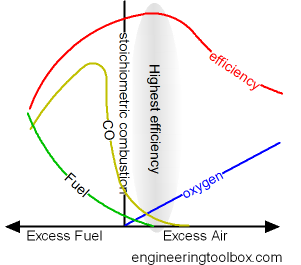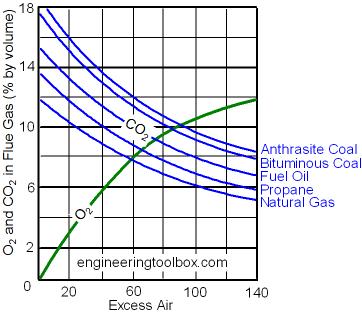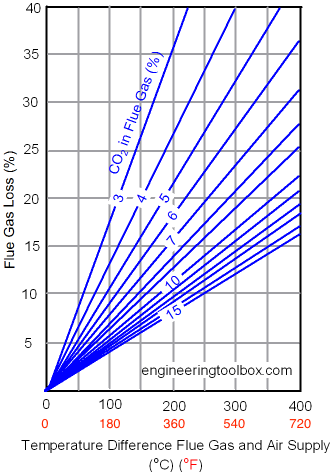Combustion Efficiency and Excess Air
Optimizing boilers efficiency is important to minimize fuel consumption and unwanted excess to the environment.
To ensure complete combustion of the fuel used combustion chambers are supplied with excess air. Excess air increase the amount of oxygen to the combustion and the combustion of fuel.
- when fuel and oxygen from the air are in perfect balance - the combustion is said to be stoichiometric
The combustion efficiency increases with increased excess air - until the heat loss in the excess air is larger than the heat provided by more efficient combustion.

Typical excess air to achieve the highest possible efficiency for some common fuels:
- 5 - 10% for natural gas
- 5 - 20% for fuel oil
- 15 - 60% for coal
Carbon dioxide - CO2 - is a combustion product and the content of CO2 in a flue gas is an important indication of the combustion efficiency.

Optimal content of carbon dioxide CO2 after combustion is approximately 10% for natural gas and approximately 13% for lighter oils.
Normal combustion efficiency for natural gas at different combinations of excess air and flue gas temperatures are indicated below:
| Excess (%) | Combustion Efficiency (%) | |||||
|---|---|---|---|---|---|---|
| Net Stack Temperature1) (oF) | ||||||
| Air | Oxygen | 200 | 300 | 400 | 500 | 600 |
| 9.5 | 2.0 | 85.4 | 83.1 | 80.8 | 78.4 | 76.0 |
| 15 | 3.0 | 85.2 | 82.8 | 80.4 | 77.9 | 75.4 |
| 28.1 | 5.0 | 84.7 | 82.1 | 79.5 | 76.7 | 74.0 |
| 44.9 | 7.0 | 84.1 | 81.2 | 78.2 | 75.2 | 72.1 |
| 81.6 | 10.0 | 82.8 | 79.3 | 75.6 | 71.9 | 68.2 |
1) "Net stack temperature" is temperature difference between flue gas temperature inside the chimney and room temperature outside the burner.
Flue Gas Loss with Oil Combustion
The efficiency loss in the flue gas related to
- temperature difference in flue gas and supply air
- CO2 concentration in the flue gas
with oil combustion is indicated below:

Example - Oil Combustion and Heat Loss in the Flue Gas
If
- the temperature difference between the flue gas leaving a boiler and the ambient supply temperature is 300 oC, and
- the carbon dioxide measured in the flue gas is 10% - then,
from the diagram above
- the flue gas loss can be estimated to approximately 16%.
Related Topics
-
Combustion
Combustion processes and their efficiency. Boiler house and chimney topics. Properties of fuels like oil, gas, coal and wood and more. Safety valves and tanks.
Related Documents
-
Boiler - Efficiency
Combustion gross and net calorific value. -
Boiler Rooms - Sizing
Minimum area in a boiler room. -
Carbon dioxide - Prandtl Number vs. Temperature and Pressure
Figures and table with changes in Prandtl number for carbon dioxide with changes in temperature and pressure. -
Carbon Dioxide - Thermophysical Properties
Chemical, physical and thermal properties of carbon dioxide. Phase diagram included. -
CO2 Calculator - Emissions from Trains
Calculator for CO2 emissions from trains, comparing with alternative forms of transportation (as plane, bus, conventional and electrical cars). -
CO2 Calculator - Emissions from Airplanes
Calculator for CO2 emissions from planes, comparing with alternative forms of transportation (as train, bus, conventional and electrical cars). -
CO2 Calculator - Emissions from Cars
Calculator for CO2 emissions from different kind of cars (gasoline, diesel, LPG, electrical), comparing with alternative forms of transportation (as airplane, bus and train). -
Combustion of Fuels - Carbon Dioxide Emission
Environmental emission of carbon dioxide CO2 when combustion fuels like coal, oil, natural gas, LPG and bio energy. -
Combustion Testing
Combusting testing of fuel oil and gas burners. -
Efficiency
The measure of usefulness. -
Flue Gases - Dew Point Temperatures
Flue gas dew point temperatures and condensation of water vapor. -
Fossil vs. Alternative Fuels - Energy Content
Net (low) and gross (high) energy content in fossil and alternative fuels. -
Fuels Flue Gases - Average Dew Points
Flue gas dew point temperatures for some fuels. -
Heating Fuels - Cost Comparing
Cost comparison formulas for heating fuels like Natural Gas, Propane LP Gas, Fuel Oil and Electricity. -
Intermittent Combustion and Boiler Efficiency
Efficiency reduction due to intermittent boiler operation. -
Oxygen - Thermophysical properties
Chemical, Physical and Thermal Properties of Oxygen - O2. -
Paraffins and Alkanes - Combustion Properties
Properties like heat values, air/fuel ratios, flame speed, flame temperatures, ignition temperatures, flash points and flammability limits.




